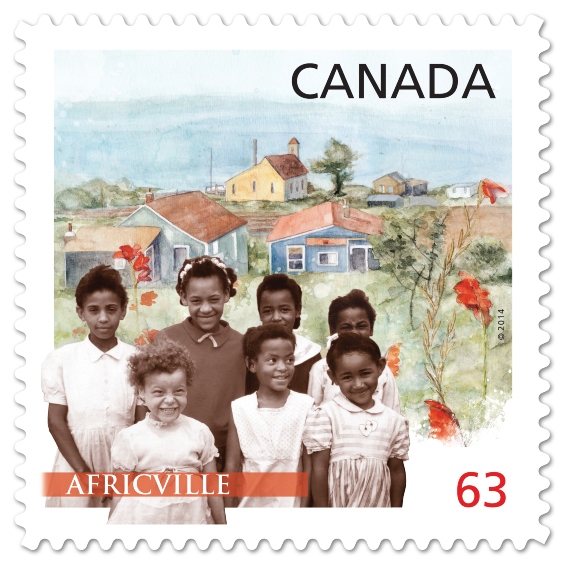Canadian Stamp Stories: Africville
Artifact


Image
Video
Audio
 Activities
Activities
LOOK
Look at the 2014 commemorative stamp of the community of Africville.
- Ask students what they see.
- Ask students what stands out to them.
- Ask students what comes to mind when they look at the stamp.
- Ask students why commemoration is important.
- Why is the community of Africville so important?
- Why is Africville commemorated with a Canada Post stamp?
DO
To understand the community of Africville, why Africville is being commemorated, and other Black communities, it’s important to do some research about these historic and contemporary Black communities across Canada.
Students should research and read about Canada’s historic and contemporary Black communities (e.g., Toronto’s Blackhurst and “Little Jamaica”) and consider the following questions: Who made/makes up these communities? When did these people arrive to that community/province? What were the circumstances surrounding their migration to that community? What was life like for people in these communities? What important institutions were found in these communities? Do these communities still exist and what are they like today?
Activity: In groups, students should choose one historic or contemporary Black community in Canada, research it, and commemorate it. Students can write a poem, write a song, create a podcast episode, create their own stamp, or choose another way in which to commemorate that community. Groups will present their community to the class and explain why they chose to highlight that historic or contemporary Black community.
THINK
Ask students why they think Africville is an important historic Black community and why it has such a long-lasting legacy.
Details
 Materials
Materials - Paper
- Ink
Historical Context
Choose one of the three levels below to match your needs.
- This stamp features young former residents of Africville.
- In the background are a number of buildings, including the Seaview African United Baptist Church, the central hub of the community.
- The stamp conveys a sense of community, joy and happiness.
This commemorative stamp highlights the Black community of Africville and its residents.
It features young Africvillians with several buildings in the background, including the Seaview African United Baptist Church, the central hub of the community.
The stamp conveys Africvillians’ sense of community, joy and happiness.
Images like this can help us to visualize the perspectives and emotions felt by a group of people, despite the wrongs and injustices they faced.
This commemorative Canada Post stamp from 2014 highlights former residents of Africville, a Black community on the outskirts of Halifax, Nova Scotia, that was founded in the mid-18th century.
The stamp features seven young residents of the community, with several buildings in the background, including the Seaview African United Baptist Church, which was the central hub of the community.
The stamp conveys Africvillians’ sense of community, joy and happiness. For many people, Africville — which was demolished by the City of Halifax in the 1960s — represents the oppression faced by Black Canadians, and the efforts to right historic wrongs.
Images like this can help us to visualize the perspectives and emotions of a group of people, despite the wrongs and injustices they faced.
- This stamp features young former residents of Africville.
- In the background are a number of buildings, including the Seaview African United Baptist Church, the central hub of the community.
- The stamp conveys a sense of community, joy and happiness.
This commemorative stamp highlights the Black community of Africville and its residents.
It features young Africvillians with several buildings in the background, including the Seaview African United Baptist Church, the central hub of the community.
The stamp conveys Africvillians’ sense of community, joy and happiness.
Images like this can help us to visualize the perspectives and emotions felt by a group of people, despite the wrongs and injustices they faced.
This commemorative Canada Post stamp from 2014 highlights former residents of Africville, a Black community on the outskirts of Halifax, Nova Scotia, that was founded in the mid-18th century.
The stamp features seven young residents of the community, with several buildings in the background, including the Seaview African United Baptist Church, which was the central hub of the community.
The stamp conveys Africvillians’ sense of community, joy and happiness. For many people, Africville — which was demolished by the City of Halifax in the 1960s — represents the oppression faced by Black Canadians, and the efforts to right historic wrongs.
Images like this can help us to visualize the perspectives and emotions of a group of people, despite the wrongs and injustices they faced.
Summary
- This stamp features young former residents of Africville.
- In the background are a number of buildings, including the Seaview African United Baptist Church, the central hub of the community.
- The stamp conveys a sense of community, joy and happiness.
Essential
This commemorative stamp highlights the Black community of Africville and its residents.
It features young Africvillians with several buildings in the background, including the Seaview African United Baptist Church, the central hub of the community.
The stamp conveys Africvillians’ sense of community, joy and happiness.
Images like this can help us to visualize the perspectives and emotions felt by a group of people, despite the wrongs and injustices they faced.
In-Depth
This commemorative Canada Post stamp from 2014 highlights former residents of Africville, a Black community on the outskirts of Halifax, Nova Scotia, that was founded in the mid-18th century.
The stamp features seven young residents of the community, with several buildings in the background, including the Seaview African United Baptist Church, which was the central hub of the community.
The stamp conveys Africvillians’ sense of community, joy and happiness. For many people, Africville — which was demolished by the City of Halifax in the 1960s — represents the oppression faced by Black Canadians, and the efforts to right historic wrongs.
Images like this can help us to visualize the perspectives and emotions of a group of people, despite the wrongs and injustices they faced.
